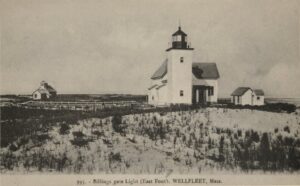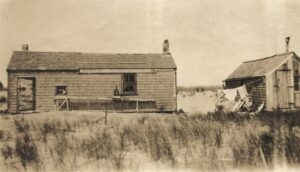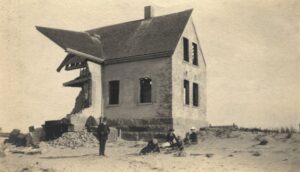WELLFLEET — “Ocean Conquers Once Prosperous Island,” blared the headline in the New Bedford Standard-Times on Feb. 16, 1936. “High Tide Now Covers Island.”

It was news, but it had been a long time coming. Billingsgate Island, located south of Jeremy Point on the bay side of Wellfleet, had been sinking for a while. The island, which in the mid-1800s had a fishing colony, a lighthouse, and a school, had been eroding for at least as long as European settlers had been there. Attempts to slow its demise were futile, and by 1936, all that remained was a muddy flat.
Despite the drama of the out-of-town headlines, accounts of the history of Billingsgate Island are hard to come by. David Hay noted in a 1970 article in the Cape Codder that no histories of the island from before its disappearance survive. Most town records that would have related to it were destroyed in the Wellfleet Town Hall fire of 1960. So, stories about the island are mostly oral tradition, recorded from time to time in newspaper histories like Hay’s.
But from these scant sources, we can glean an idea of what life was like on Billingsgate Island before it sank beneath the waves.
Billingsgate was the end of a small chain that included Bound Brook, Griffin, and Great islands, which, at various points, have been connected and disconnected from the mainland. It rose no more than 10 feet above the high tide line, and was likely mostly covered in beach grass, though some accounts claim there was fertile enough soil to pasture animals there. It may have also had a small forest. Doug Fraser wrote in the Cape Cod Times in 2003 that fishermen had said they could hook cedar stumps in the waters off the island from time to time.
It was sometime in the mid-1700s that erosion severed the link between Billingsgate Point and Great Island and turned Billingsgate into an island of about 60 acres at the time.
Despite its small size, the island proved to be important to the town’s economy. It was during the 1700s that Wellfleet Harbor became recognized as a fishing port. The word “Billingsgate” is a reference to the famous Billingsgate fish market in London and was the name given to the town we now know as Wellfleet. The island was also at that time known for its valuable shellfishing flats and as a useful base for whaling. Later, Thomas K. Payne, who was Billingsgate’s lighthouse keeper in 1869-70 and again from 1876 to 1884, wrote that a team of 14 clamdiggers could reap 35 barrels of clams in a day. Other entries in his log included a fisherman who caught 10,000 mackerel in a day, and a group of whalers killing 18 whales in a little over a week.

Control over such a resource-rich island had been a point of contention. In 1757, a group of Indigenous people from the Potenummecut community near present-day Harwich alleged in a petition filed in the Harwich general court that a white settler named Sylvanus Snow had prevented them from whaling or cutting thatch from Billingsgate Island, effectively displacing them from their lands. Making their case, they wrote “that there is not its like so convenient a place for whaling and other fishing within ye county,” particularly among “what little lands that are still kept in our hands.”
The court sided with the Potenummecut and declared they could maintain their rights to fishing and harvesting the land. Still, disease brought by the Europeans and gradual disenfranchisement continued to ravage the community, and by the early 1800s there was a sizable community of white settlers there.
In 1822, the United States Lighthouse Board saw fit to put a lighthouse on Billingsgate Point, which by then had become separated from the rest of Billingsgate Island by a channel, according to an 1831 map of Wellfleet. It was only the third lighthouse constructed on Cape Cod, following the Highland Light in Truro and Race Point Light in Provincetown.
The mid-1800s seems to have been the heyday of Billingsgate Island. There were approximately 30 houses on the island, all of which were owned by fishermen and used mainly seasonally.
Henry David Thoreau, in Cape Cod, describes a peculiar practice of bird hunting popular on the island during that period. He wrote that his “grizzly” oysterman’s house host recounted how men would go to the island at night and light fires to attract small gulls, which the men would then kill with frying pans.
The islanders, along with residents of Griffin and Bound Brook islands, pooled some money to build a schoolhouse on Billingsgate for their children in 1844, according to an unsigned history of the Billingsgate Light found in the archives at the Wellfleet Historical Society.
Already then there were signs of the island’s eventual doom. The lighthouse was destroyed by the tides in 1854, and a new lighthouse was built in 1858. Ten years later, it had to be moved uphill as rising tides crept up the beach.
The lighthouse keeper logs from this era reveal how quickly the erosion was happening. Keeper Herman Dill wrote that an exceptionally high tide on Nov. 18, 1872 had flooded the lighthouse. The following year, he wrote that the island had lost 15 feet of shore in one day. “I do not know but the island will all wash away,” he wrote. A month later, another storm flooded the lighthouse with three to five feet of water. Dill would die the following spring, frozen in his lighthouse dory as he made for shore following a particularly severe March storm.
By the late 1890s, only a few houses remained. Some of those that were gone were floated over to Wellfleet, while others were surely lost to the sea. The schoolhouse closed when the number of active houses on the island dropped to six, according to Daniel Lombardo’s history of the island. Erosion made life so difficult that the lighthouse keeper was typically the only person who spent the winter there. Most of the people on Billingsgate were by then shellfishermen making trips during exceptionally low tides, tourists hosting clambakes in the summer, and hunters looking for ducks in the fall.

It’s from this era that we get one of the few first-person accounts of life on Billingsgate, written by Earle Rich in the Cape Codder in 1969. He described visiting the island in the early 1900s, when he was a kid, accompanying his shellfisherman father. He recalled the island’s sheltered bay, full of moored boats; a high-spired hunting lodge owned by renowned Harvard surgeon Maurice Richardson; the lighthouse keeper George Bailey’s family, including a boy and girl Rich’s age, who lived on Billingsgate year-round alongside their pigs and a flock of chickens; and Emil Poikonen, also known as “Amos the Finn,” who was the last fisherman to live on the island.
But erosion lumbered on. Rich wrote that in 1905 the federal government attempted to construct a breakwater on Billingsgate to protect the lighthouse, but he supposed that only sped the erosion up. Bailey left the island around then, and in 1915, the lighthouse was replaced by an automatic beacon. That same winter, a blizzard hit the Cape, and “the old facility tumbled into the sea,” Rich wrote.
Through the 1910s and ’20s, Billingsgate eroded further. According to the 1936 article in the Standard-Times, the remaining land — just five acres by then — had been sold to the Federated Bird Clubs of New England in 1928 for use as a bird sanctuary.
Less than a decade later, Billingsgate was gone, and no bird would find refuge on its banks. Rich wrote of Billingsgate’s erosion with the same sadness one would write of a house fire. “It was the mother hen to a brood of around 100 chickens, as that was the number of vessels hailing from Wellfleet at the time,” he wrote. He also wrote about local expressions like “the Day Uncle Heman died,” or legends like the mysterious bright light that lingered over the fishing spot known as “Lumpkin’s Hole,” as being casualties as well. “It’s ironic such sayings died at the same time Billingsgate disappeared into the sea forever.”
When the island disappeared, the Federated Bird Clubs, hoping to receive a tax deduction, listed Billingsgate Island as a gift to the Commonwealth of Massachusetts according to the Standard-Times. “I do not know whether the Commonwealth ever acknowledged the ‘gift,’ ” wrote the unnamed reporter from that paper’s Cape Cod bureau. “The tide acknowledged nothing.”



